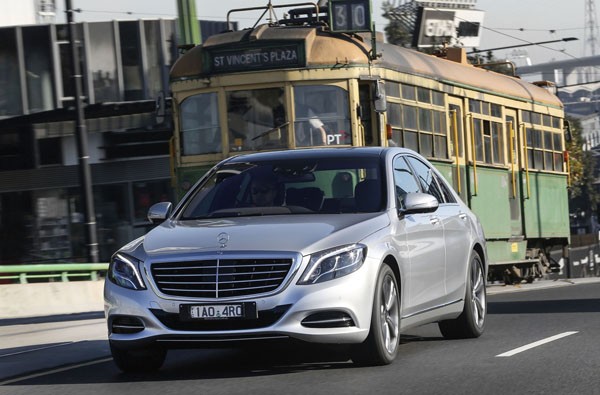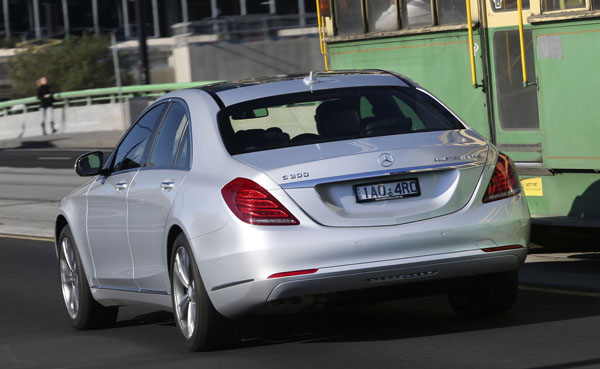
 In a fascinating move, Mercedes-Benz has launched the hybrid version of its new S 300 Hybrid at a significantly lower price than the rest of the S-Class range. With a recommended price of $195,000 (plus on-road charges) the high-tech hybrid undercuts the previous lowest cost model, the S 350 by $20,000.
In a fascinating move, Mercedes-Benz has launched the hybrid version of its new S 300 Hybrid at a significantly lower price than the rest of the S-Class range. With a recommended price of $195,000 (plus on-road charges) the high-tech hybrid undercuts the previous lowest cost model, the S 350 by $20,000.
Mercedes-Benz Australia seems nervous about entering this new, to it, market area so is treating the S-Class S 300 BlueTEC HYBRID (to give it its convoluted full title) as a toe-in-the-water exercise.
Having just carried out our first road tests in harsh driving conditions – Melbourne traffic during peak hour – we feel the local Mercedes people will rapidly gain confidence.
Some equipment has been removed from the S-Class hybrid to achieve its price, it misses out on the top-end audio system and a few other bits and pieces, but it looked and felt upper-luxury to us during our drive. The company possibly has accepted a smaller profit margin to get things underway, but is obviously not going to reveal that, if it is the case.
 Interestingly, the only real competitor to the S-Class hybrid is the Lexus LS600h, and it has a recommended price higher than the standard LS460. However it takes the opposite route, being aimed at the sports-luxury market and using a V8 engine. So Merc to Lexus hybrids is not an apples-to-apples comparison.
Interestingly, the only real competitor to the S-Class hybrid is the Lexus LS600h, and it has a recommended price higher than the standard LS460. However it takes the opposite route, being aimed at the sports-luxury market and using a V8 engine. So Merc to Lexus hybrids is not an apples-to-apples comparison.
ENGINE / TRANSMISSION
The Mercedes-Benz hybrid system consists of a 2.1-litre turbo-diesel engine developing 150 kW of power. Immediately behind the engine where the torque convertor usually sits, is what Mercedes calls an ‘electric machine’. This works as a combined starter/generator that starts the diesel as required, and regenerates power in the form of electricity generated by the mass of the vehicle when it slows down, as well as its regenerative brakes.
Finalising the drivetrain is an eight-speed conventional automatic transmission.
 A medium-large battery is installed under the rear of the S-Class. It steals 20 litres from the boot space, but there’s still plenty of volume left.
A medium-large battery is installed under the rear of the S-Class. It steals 20 litres from the boot space, but there’s still plenty of volume left.
Official measurements give the S-Class hybrid a fuel consumption of an ultra-low 4.5 litres per hundred kilometres on the combined cycle. However, all hybrids are famously good at producing excellent results on dynamometers but with real life driving results in consumption 20 to 35 per cent higher.
DRIVING
The really clever thing is that you never realise this Mercedes-Benz hybrid is anything other than a normal S-Class. It starts off under electric power alone and steals along in total silence for the first 10 to 200 metres, depending on conditions and driving style, until the turbo-diesel kicks in.
The boost from the high-torque electric motor is instantaneous and works beautifully with the torque generated by the diesel.
The Aussie drivers’ term ‘grunt’ somehow doesn’t seem appropriate when describing a sophisticated, high-tech German Mercedes – but the fact remains that’s there is plenty of grunt all the way through the range. We love it…
Performance is silky smooth with the sort acceleration you would expect from a 3.0-litre six-cylinder Mercedes powerplant – which is where the ‘300’ in the S-Class S 300 BlueTEC HYBRID’s name comes from.
Slowing down and/or braking doesn’t create the same whining sound as in many other hybrids we have road tested.
Under normal driving the car may never use the conventional hydraulic brakes, thus it also reduces air pollution created by brake dust.
When the car stops so does the turbo-diesel engine. You can just feel this happening if you really concentrate, but it really is almost completely unobtrusive. It’s the same when the diesel restarts, you really don’t know anything unusual is taking place.
All of the ancillaries, including the air conditioning, are electrically powered, so there’s no need for the turbo-diesel to kick in when the S-Class is stopped.
Fuel consumption? We never got anywhere near the official figure of just 4.5 litres per hundred. Which, as detailed earlier, didn’t come as a surprise. Our driving was done from the airport on the Tullamarine Freeway, then off at Bulla Road for torturous trip into the city centre to the conference area for technical presentations, followed by a light lunch. Then back to the airport via Moonee Ponds and, eventually, the Tulla Freeway and the airport.
These test runs would approximately have equated to the official 81/02 driving cycle used to measure fuel consumption and CO2 emissions. The combined cycle sees cars run in laboratory conditions for about 60 per cent of the time in urban running, and 40 per cent in the country.
Our overall fuel use was 6.3 litres per hundred kilometres. Well over the 4.5 litres officially obtained, but still astonishingly low for a two-tonne luxury cruiser in harsh driving conditions.
SUMMING UP
Mercedes-Benz S-Class hybrid offers excellent valve for money in this top-end class. It’s exceptionally clean in all conditions, even more so when stationary in traffic in big cities so will bring a smile to the faces of those who can travel in luxury while causing minimal damage to the climate.











